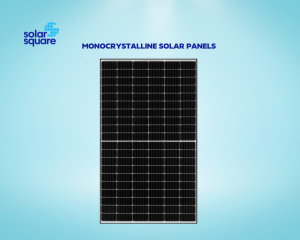
Solar cell efficiency is nothing but the ratio of output energy to the input energy from the sun. The percentage of sunlight that a solar cell can convert into electricity determines the efficiency of a solar panel.
The more the sunlight, the greater the efficiency of the solar panel will be. However, there are other factors that determine solar cell efficiency, such as:
- How clean the panels are
- The material of the solar panel
- The area available for installation
If a solar panel claims 15% efficiency, that means it can convert 15% of the solar energy into electricity.
With technology, solar panel efficiency has increased. Nowadays, there are solar panels that work even on cloudy days, giving efficient results.
How efficient are solar panels?
Solar panels can also work on gloomy days; however, the solar cell efficiency decreases by a certain amount. Solar panels enhance their efficiency in winters.
In the present days when there’s abundant sunlight, solar panels provide a solar cell efficiency of up to 22 percent. According to the National Renewable Energy Laboratory, solar efficiency on a sunny day varies between 16 percent and 20 percent.
Efficiency also affects the price of solar panels. As a matter of fact, the solar panels that provide an efficiency rate above 20 percent come with a higher price.
An average house can run on solar panels with a 15-20% efficiency rate.
How solar panel efficiency differs from material to material?
Solar cell efficiency varies according to the material they are made of. Let’s find out the details!
#1. Silicon
Silicon is the most widely used material in solar panels because it’s durable. It has the best energy conversion efficiency of up to 22%.
For more durability, many manufacturers coat silicon with silicon nitride.
#2. Gallium arsenide
Gallium arsenide is becoming popular because of its efficiency. Did you know that it is a mixture of gallium and arsenic? It’s an excellent semiconductor.
The downside is that gallium is costly and produces toxic gases while being manufactured.
Fun fact: Two other semiconductors include soluble platinum and organometallic. These are lightweight and cheap to manufacture.
What determines the efficiency of solar panels?
Before moving to what determines the efficiency, there are two terms that you should know about solar panel efficiency: total panel efficiency and photovoltaic cell efficiency.
The photovoltaic cell efficiency is determined by the cell’s design, the material used, the layout of the cell, its configuration, and the panel size.
The total panel efficiency is calculated by dividing the maximum power rating at STC by the total panel area in square metres.
Coming to the main point, solar cell efficiency is determined by several other factors. The most important ones are as follows:
- Tilt
- Orientation of the panel
- Latitude
- Climate
- Material of solar panel
- Area of panel
- How clean the panels are
Top 3 Miscellaneous factors that determine solar cell efficiency
1. Temperature
In general, solar cells perform best at lower temperatures. An increase in temperature causes the semiconductor characteristics to change. The result is a modest current rise but a significant voltage fall.
2. Shade
A modest amount of shadow on solar panels can significantly diminish their output. Panels in a system are closely linked together. Even a slight bit of shadow on one panel can dramatically reduce the system’s overall solar efficiency.
3. Right position
For solar panel efficiency, the installation angle of the panel is essential. 10° is usually the right tilt angle in South India. As you move towards the North, the title angle increases. The ideal tilt angle for North India is usually more than 20°.
How is the solar cell efficiency calculated?
The cell efficiency is mentioned on the manufacturer’s list when you buy a solar cell. However, the value is often under STC conditions, and it is useless if your model does not operate under STC conditions.
The formula for calculating solar efficiency is;
Efficiency = power output by the solar panel/area of the solar panel x solar radiance x 100
You can find the solar cell’s surface area at the back of the panel. To calculate the surface area, you can multiply the length and breadth of the solar panel.
Types of solar panels and their efficiencies
There are three primary types of solar panels, i.e. monocrystalline, polycrystalline, and thin-film.
Monocrystalline is the most efficient solar panel and is used widely in residential and commercial applications for its efficiency.

- It is made of silicon and has an efficiency rate of 15 to 22 percent.
- It requires much less space as compared to a polycrystalline or thin-film solar panel.
- Monocrystalline solar panels can last for more than 20 years because they are made of silicon that’s immensely durable.
A Polycrystalline solar panel is made by melting silicon crystals and clubbing them together.
- It is an excellent choice for small as well as large-scale applications.
- It is made in between the power range of 5W to 250W.
- Its efficiency rate is between 13% to 16%.
Thin-film solar panels are very lightweight, flexible, and portable. But, they’re a lot less efficient than their counterparts.
Conclusion
Solar energy is a great way to reduce your electricity bills and carbon footprint. Buy a solar panel that provides greater efficiency, at least up to 15-16%.
Owning a solar panel isn’t an expensive task. Most solar panels are designed in a way that they are long-lasting and require little maintenance.
FAQs
1. What is the lifespan of solar panels?
Solar panels last for a good 20 to 30 years.
2. How can the efficiency of solar panels be improved?
Solar panels should be kept clean. Any accumulation of dirt or dust can reduce their lifespan.
3. What is the average solar panel efficiency?
A. The average solar panel efficiency is 15 to 20 percent.
